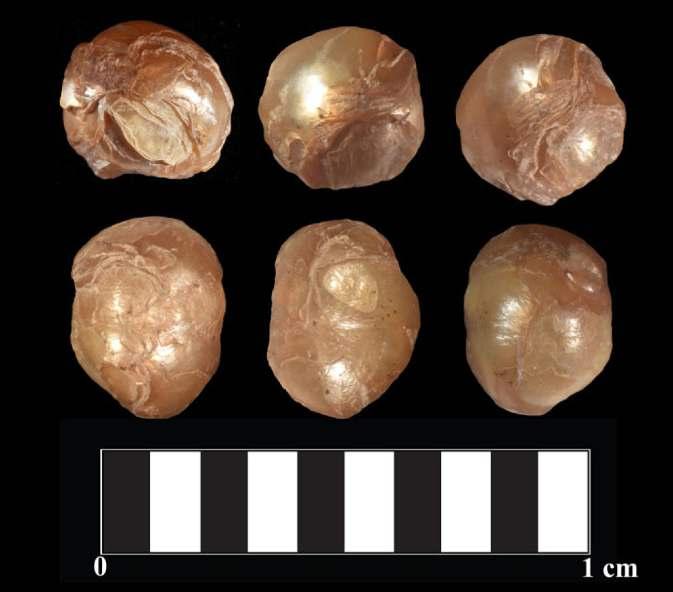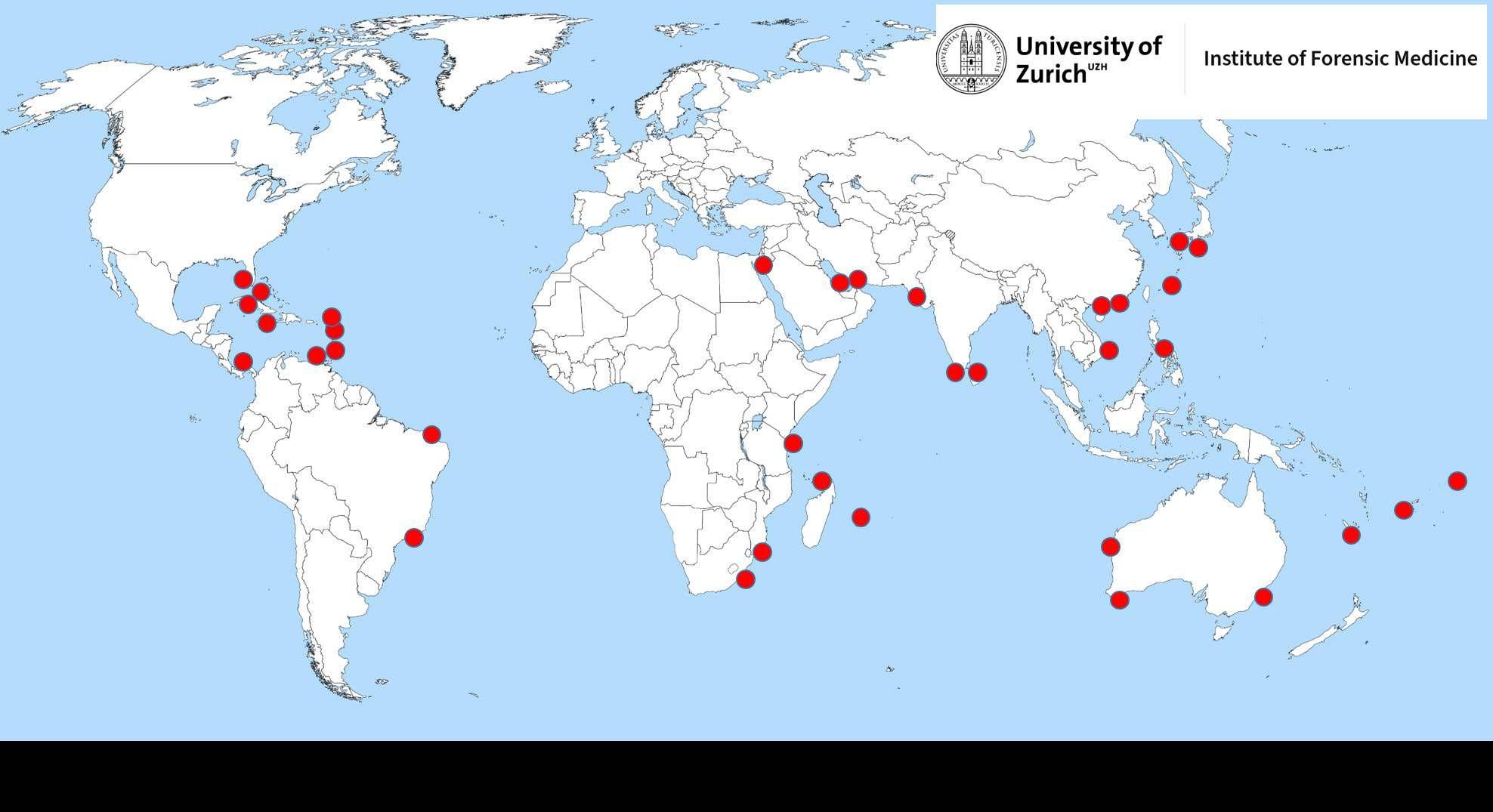
IGC, TOKYO | OCTOBER, 2023


IGC, TOKYO | OCTOBER, 2023
Presentation by Dr. Laurent E. Cartier FGA

• Deoxyribonucleic acid (DNA): Contains all the information an organism needs to develop, live and reproduce. It is formed by the four nucleobases (or ‘bases’) adenine (A), cytosine (C), guanine (G) and thymidine (T). The order of the bases (e.g. ATCGGTT…) codifies the specific instructions for any living organism.
• Genome: An organism’s full set of DNA, including all of its genes.

A pearl generally consists of 95% CaCO3 and 5% H2O & organic matter.








MICADAS Mini Carbon Dating System (Accelerator Mass Spectrometer).
Image ETH Zurich & ionplus AG
Figure: M.S. Krzemnicki, SSEF Using background illustration From www.fisheriesireland.ie

Sampling for age dating and DNA is carried out using similar method. Lowest sample weight used to data has been 2mg (0.001 carat, 0.004 grains).

21.47 ct




A minute amount (less than 0.004 g) of calcium carbonate is taken from inside the drill-hole.
„quasi“ non-destructive testing even for objects of archaeological and cultural heritage.




0.02 ct powder of calcium carbonate for age dating.




Water reservoir age (old age effect)
Analysed raw data has to be corrected for reservoir age. This means that the geographic location of the pearl should be known (at least approximately).
Contamination with geological calcium carbonate and diagenesis
Difference between suspension feeder (e.g. Pinctada molluscs) and
Soil grinding feeder (e.g. haliotis or other gastropods).
Difference between material from excavations and “fresh” shells/pearls in jewellery


Source:
http://radiocarbon.ldeo.columbia.edu/research/resage/res_ff.cgi

This natural pearl was recovered (via shells found in the site) from Umm Al Quwain in U.A.E and was dated back to 5550 B.C.


Source: Charpentier et al., 2012



Source: Szabo et al. 2015
AMS radiocarbon dating of two modified pearls from the CovachaBabisuri site, Espíritu Santo Island, Baja California Sur, México, corroborates that traditional indigenous use and modification of pearls as items of adornment began at least 8,500 years ago. These are the oldest published modified pearls found in dated archaeological contexts anywhere in the world.

Source: Ainis et al. (2019)

The ‘Queen Mary Pearl’ was once owned by Queen Mary (1867-1953).
A drop-shaped natural pearl of 41.5 ct (166 grains) of finest quality and lustre, approximately 16.45 -17.65 x 21.80 mm
For comparison, the Peregrina pearl: weighs approximately 202.24 grains or 50.56 carats, measuring approximately 17.35 - 17.90 x 25.50 mm






The purple band is the marine calibration curve (Heaton et al., 2020), and the green band is the atmospheric curve (Reimer et al., 2020).



pearl necklace from Pteriasterna analysed by DNA fingerprinting


Map showing habitat of Pteriasterna(name rainbow-lipped pearl oyster or Pacific wing oyster


Characteristic reddish reaction under long-wave ultraviolet light.
This pearl jewellery set consisted of 63 natural pearls, with 61 of them being strung on a thread and two additional loose natural pearls. Three pearls were freshwater natural pearls, and it contained pearls from different species, including one not previously known to produce natural pearls (Pinctadapersica).

100% unique DNA match with Pinctadapersica

100% unique DNA match P.radiata (genotype 1)
100% unique DNA match with Pinctadapersica
As is often case with radiocarbon dating, the determined age indicates a period in history rather than a precise date. Based on our data, they probably formed between the 16th and 18th century AD with the highest probability of formation having been in the 17th century.


Pinctadapersicawas previously known as Pinctadamargaritiferavar.persica (Jameson, 1901; Lal et al., 2017), but recently has been recognized as a new species (Ranjbar et al., 2016).
Unlike its closely related species (P.margaritifera), P.persicahas a distinct phenotypic color morph of mantle tissue, so that the orange mantle color of P.persicais the dominant morphotype compared to the black one.
Souce: Parvizi et al. (2017)


Akoya complex includes Pinctadafucata-imbricata-martensii-radiata species.


Pinctadamargaritiferacomplex includes: var. cumingii , var. typica , var. zanzibariensis , var. galtsoffi .




Mexico had a plentiful supply of mother-of-pearl from oyster-beds off the coast of Baja California, as Hernán Cortés and the so-called conquistadores discovered (1522)when they encountered Pericú Indians wearing necklaces strung with red berries, shells and blackened pearls.












Precious corals consists of 8 main species used in the jewellery industry:
• Coralliumrubrum(Mediterranean coral)
• Coralliumjaponicum(including oxblood coral)
•Pleurocoralliumelatius(including angel skin coral)
• Pleurocoralliumkonojoi(white coral)




• Pleurocoralliumsecundum(including Midway coral)
•Hemicoralliumregale

•Hemicoralliumlaauense

•Hemicoralliumsulcatum


: CITES Appendix III listing (species included at the request of a country which then needs the cooperation of other countries to help prevent illegal exploitation).

Discovery of a ‘new’ species (Pleurocoralliumniveum , from the Hawaiian archipelago) that has never before been reported in the jewellery industry, but was identified in several submitted coral cabochons tested in different studies. Results of our ongoing research show that Pleurocoralliumniveum(non-CITESlisted) corals were often mistakenly identified as Pleurocoralliumsecundum (CITES-listed).
Right: A precious coral cabochon submitted as that was submitted as Pleurocorallium secundum but was identified as Pleurocorallium niveumusing DNA fingerprinting. Photos: Bertalan Lendvay and SSEF.


The six taxonomic groups distinguishable by the Coral-ID assay. Note that species in the species complexes cannot be differentiated based on mitochondrial markers. From Lendvay et al. (2022). For precious coral taxonomy, see Tu et al. (2015).




